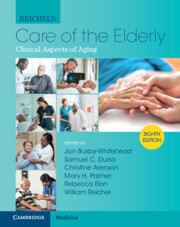Book contents
- Reichel’s Care of the Elderly
- Reichel’s Care of the Elderly
- Copyright page
- In Memoriam
- Contents
- Contributors
- Section I General Approach to the Care of the Elderly
- Section II Geriatric Syndromes
- Section III Care of the Elderly by Organ System
- Section IV Principles of Care for the Elderly
- Chapter 46 Surgical Principles
- Chapter 47 Rehabilitation
- Chapter 48 Geriatric Sexuality
- Chapter 49 Aging in Adults with Intellectual Disabilities and Severe and Persistent Mental Illness
- Chapter 50 Home- and Community-Based Long-Term Care
- Chapter 51 Institutional Post-Acute and Long-Term Care Medicine
- Chapter 52 Hospital-Based Care
- Chapter 53 Introduction to Palliative Care
- Chapter 54 The Mistreatment of Older Adults
- Chapter 55 Driving and the Older Adult
- Chapter 56 Integrative Medicine
- Chapter 57 Retirement
- Chapter 58 Cultural Competence
- Chapter 59 Health Literacy
- Chapter 60 Caregiving
- Chapter 61 Practice Transformation for Better Care of Older Adults
- Chapter 62 Health-Care Organization and Financing
- Chapter 63 Ethical Decision-Making
- Chapter 64 Epidemic and Pandemic Impacts on the Elderly Population
- Index
- Plate Section (PDF Only)
- References
Chapter 53 - Introduction to Palliative Care
from Section IV - Principles of Care for the Elderly
Published online by Cambridge University Press: 30 June 2022
- Reichel’s Care of the Elderly
- Reichel’s Care of the Elderly
- Copyright page
- In Memoriam
- Contents
- Contributors
- Section I General Approach to the Care of the Elderly
- Section II Geriatric Syndromes
- Section III Care of the Elderly by Organ System
- Section IV Principles of Care for the Elderly
- Chapter 46 Surgical Principles
- Chapter 47 Rehabilitation
- Chapter 48 Geriatric Sexuality
- Chapter 49 Aging in Adults with Intellectual Disabilities and Severe and Persistent Mental Illness
- Chapter 50 Home- and Community-Based Long-Term Care
- Chapter 51 Institutional Post-Acute and Long-Term Care Medicine
- Chapter 52 Hospital-Based Care
- Chapter 53 Introduction to Palliative Care
- Chapter 54 The Mistreatment of Older Adults
- Chapter 55 Driving and the Older Adult
- Chapter 56 Integrative Medicine
- Chapter 57 Retirement
- Chapter 58 Cultural Competence
- Chapter 59 Health Literacy
- Chapter 60 Caregiving
- Chapter 61 Practice Transformation for Better Care of Older Adults
- Chapter 62 Health-Care Organization and Financing
- Chapter 63 Ethical Decision-Making
- Chapter 64 Epidemic and Pandemic Impacts on the Elderly Population
- Index
- Plate Section (PDF Only)
- References
Summary
Palliative care, an approach to care that improves the quality of life of patients and families, has rapidly become the standard of care for patients with serious illness in recent decades. A large body of quality evidence supports interprofessional palliative care delivery as a means to improve symptom control, mood, and communication and result in less aggressive treatment at the end of life. One large component of this palliative care is skilled, structured communications; meeting with patient, family, and other medical specialists involved with complex patient care. Additionally, focus on pain and symptom control requires a nuanced approach, especially in the older adult at higher risk of drug-related adverse events. Increasingly important to understand is the complexity in use and prescription of opioids. They have both intended and unintended consequences of use; both effective pain control in serious illness and diversion or misuse. Pain, nausea, vomiting, dyspnea, and delirium increase in prevalence as patients burden of illness increases. Pharmacotherapy and non-medication-based interventions are both often effective as patients approach the end of life. Hospice remains the gold standard of care for dying patients, but because many people still die in hospital settings, it is critical that clinicians are knowledgeable in providing end-of-life care.
Keywords
- Type
- Chapter
- Information
- Reichel's Care of the ElderlyClinical Aspects of Aging, pp. 650 - 663Publisher: Cambridge University PressPrint publication year: 2022



